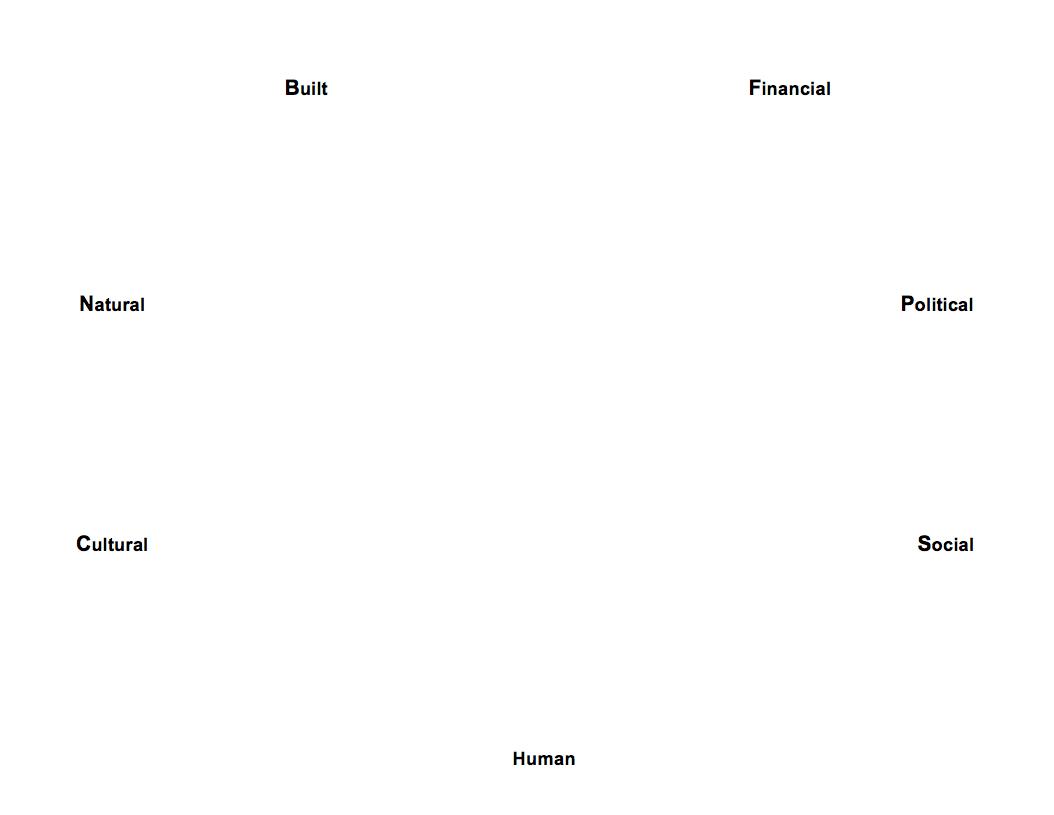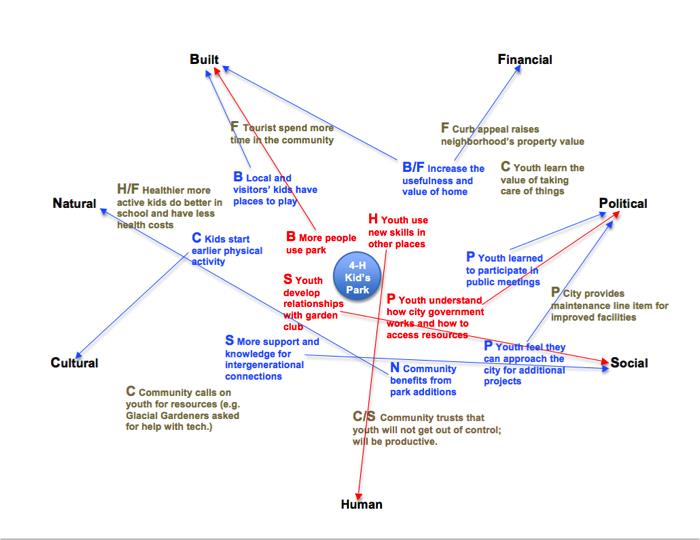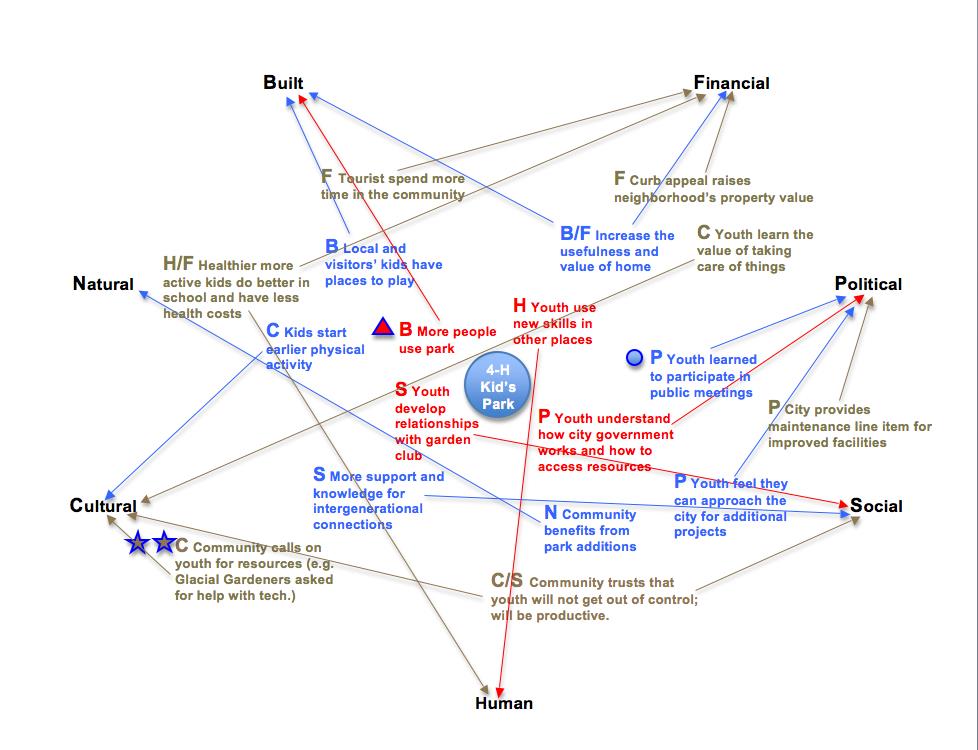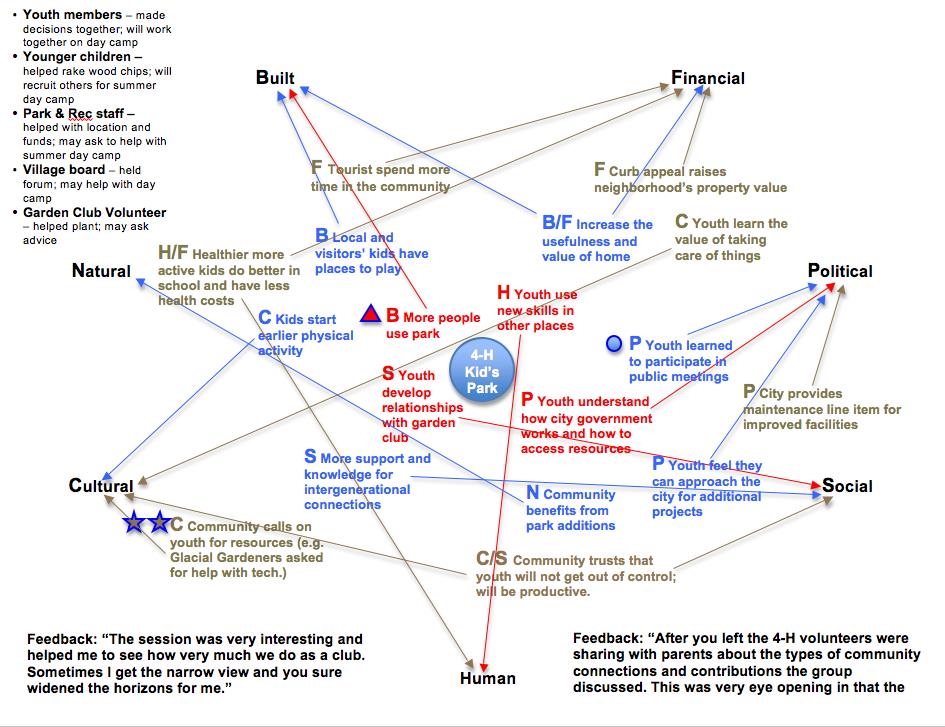 |
February 2013
|
February 2013 // Volume 51 // Number 1 // Tools of the Trade // v51-1tt7
Contributions of Youth Engagement to the Development of Social Capital Through Community Mapping
Abstract
The Multi-State North Central Extension Research Activity (NCERA), Contributions of 4-H Participation to the Development of Social Capital, identified a strategy to pilot a research method that incorporates an inquiry-based approach to understanding community level impact of youth programs. This article focuses on how youth engagement educators can use this strategy to engage youth and to understand the impact of youth engagement on community change work.
Introduction
Research on indicators of positive youth development (Benson, 1997; Blum & Rinehart, 1997; National Research Council Institute of Medicine, 2002; Perkins & Borden, 2003; Zeldin, 2004) demonstrates the importance of and need for connecting young people to caring adults in their communities. Youth development researchers and professionals now know meaningful, supportive connections with non-family adults can positively influence the path and quality of young people's lives. These connections can be described as social capital. Social capital reflects the connections among people and organizations or the "social glue" to make things happen. Bonding social capital refers to those close ties that build community cohesion. Bridging social capital involves weak ties that create and maintain bridges among organizations and communities.
Youth engagement educators are looking for strategies to engage youth and to understand the impact of youth engagement on community change work. In fact,
There is a need for Extension agents, program developers, and policy planners to better understand the role of youth in the community development process. Equally important, a need exists to better recognize the benefits and opportunities presented through youth involvement in community development activities. Extension plays a vital role in engaging youth through interactions with the local community, particularly in the implementation of 4-H programs (Brennan, Barnett, Baugh, 2007).
We know that youth, 4-H youth in particular, contribute positively to their local communities, but more evaluative impact must be gathered in order to demonstrate this.
The Multi-State North Central Extension Research Activity (NCERA), Contributions of 4-H Participation to the Development of Social Capital, identified a strategy to pilot a research method that incorporates an inquiry-based approach to understanding community level impact of youth programs. In particular, a mapping process was identified that highlights the extent to which youth are engaged in their community.
The mapping methodology is a strategy used to capture the extent to which youth are engaged in their community and to reveal the layers of involvement to which youth participate. How do youth build social capital? What are the community institutions that promote (explicitly or tacitly) social capital? Who are the people that are central to the development of social capital (bonding social capital)? What are the points of connection that demonstrate social capital (bridging social capital)?
The Mapping Process
The technique used to gather useful data from youth participants is called "spider mapping" or "graphing." It is not only a collection of data and information, but it is also a visual representation of the layers of connections and the detail of those relationships that youth have. It shows the depth and breath of social capital and how the various connections are interdependent and simultaneously distinct. The beauty, however, is that the youth is central to these networks and is the glue that bonds and bridges these disparate relationships.
First, identify the capitals that make up a community, as shown in Figure 1.
Figure 1.
Community Capitals

Next, in the center draw a circle and write the name of the program or activities for which you will map the impact (shown in red in Figure 2)
Figure 2.
Program or Activity

Determine the immediate results of the program by asking how are things different as a result of your activities. Ask: What are the people doing differently? What effect did participation have on attitudes, behaviors, knowledge and actions? (shown in blue in Figure 3).
Figure 3.
Results of the Program

Determine what is changing as a result of doing things differently. Ask: who benefits from the activity? How, as a result of the things that people are doing differently? Draw lines to connect items (shown in blue and red lines in Figure 4).
Figure 4.
Changes in the Community

The last layer may answer questions about impact, as shown in Figure 5. Map thoughts about how institutions, agencies, or systems have changed as a result of the outcomes mapped earlier. Identify the most significant change on the map. Place a star next to the item.
Identify items most connected to social capital. Draw a circle around those.
Identify items connected to new relationships or opportunities. Place a triangle next to the item.
Figure 5.
Institutional, Agency or Systems Change

The connections that youth have established throughout the entire community are shown in Figure 6. The connections highlight the varied and diverse relationships that youth forge with many institutions and people.
The symbols (triangles and circles) demonstrate the depth of those relationships.
Figure 6.
Community Connections Made by Youth

Conclusion
The mapping process is a powerful visual representation of the relationships and networks that 4-H youth build as a part of their 4-H experience. Social capital, according to the Committee on Community-Level Programs for Youth, is a practical method for examining the linkages and connections, and hence the developmental resources, a young person experiences in a particular setting (National Research Council Institute of Medicine, 2002).
Youth and others have a chance to witness just how connected and linked they are to not only each other, but also to the larger community of people and institutions. Mapping is a strategy—a visual strategy—to validate (or not) the sprawling ties that youth have helped create in their community.
References
Baker, B., Calvert, M., & Emery, M. (2011) Mapping your impact in the community. In National 4-H Council engaging youth serving community: Tools for evaluation of your EYSC project. Retrieved from: http://fyi.uwex.edu/youthadultpartnership/2012/05/30/tool-for-mapping-community-impact/
Benson, P. L. (1997). All kids are our kids: What communities must do to raise caring and responsible children and adolescents. San Francisco: Joss-Bass
Blum, R. W., & Rinehart, P. M. (1997). Connections that make a difference in the lives of youth. Retrieved from: http://casel.org/publications/reducing-the-risk-connections-that-make-a-difference-in-the-lives-of-youth/ on January 20, 2012.
Brennan, M. A., Barnett, R. V., & Baugh, E. (2007). Youth involvement in community development: implications and possibilities for extension. Journal of Extension [On-line], 45(4) Article 4FEA3. Available at: http://www.joe.org/joe/2007august/a3.php
National Research Council and Institute of Medicine (2002). Community programs to promote youth development. Committee on Community Level Programs for Youth. Jacquelynne Eccles and Jennifer A. Gootman, eds. Board on Children, Youth and Families, Division of Behavioral and Social-Sciences and Education. Washington D.C: National Academies Press.
Perkins, D .F. & Borden, L. M. (2003). A multidimensional ecological examination of a youth development program for military dependent youth. Journal of Prevention & Intervention in the Community, 27, 2, 49-675.
Zeldin, S. (2004). Youth as agents of adult and community development. Applied Developmental Science, 8, 2.




